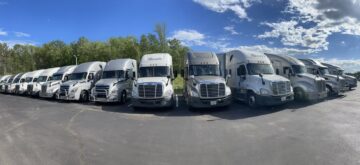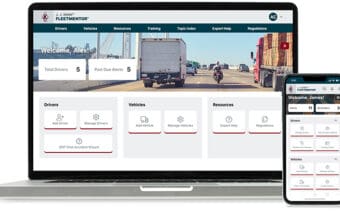
May 5, 2023
OSHKOSH – The flying of airplanes has been around since the first efforts of the Wright Brothers in 1903 in Kitty Hawk, North Carolina.
Almost 120 years later, if airplane travel is to continue as we know it today, a national pilot shortage will have to be addressed – and soon.
According to U.S. Bureau of Labor Statistics, there will be an estimated 18,000 airline and commercial pilot vacancies per year over the rest of this decade.
“We’re definitely in need of pilots and the mechanics who work on the planes,” Jared Huss, director of aeronautics at Fox Valley Technical College (FVTC), said. “It seems almost daily we see something on the news about a close call in the air, somebody getting hurt or they’re talking about canceled flights because of staffing shortages – it’s a strained workforce right now.”
American Aviator Act of 2023
In an effort to help ease the pilot shortage, Huss said FVTC has given its support to a federal training grant proposal that would help veterans become commercial airline pilots.
U.S. Senators Tammy Baldwin (D-WI) and John Hoeven (R-ND) have reintroduced the American Aviator Act of 2023, which would authorize grant funding through the Federal Aviation Administration (FAA) to support training opportunities for veterans who aren’t already military pilots.
//17bec5072710cda5b8dd81b69f4c6e58.cdn.bubble.io/f1683303835793x275167629396154900/richtext_content.webpJared Huss, director of aeronautics at Fox Valley Technical College, said a student can earn his/her pilot’s certification in about a year and a half. Photo Courtesy of FVTC
If approved, the grant would cover the cost of tuition, training services, books and other training resources for veterans.
“We have a well-established aviation program at FVTC,” Huss, who is in his 17th year at the college, said. “We appreciate the legislative support toward this proposal. There are already some funding mechanisms in place for veterans, but it doesn’t mean all the training program costs are covered. This is meant to make this a feasible goal and bridge that gap for any veteran who qualifies to become a professional pilot. It’s a great pool of candidates to help serve our nation’s needs.”
Huss said the bill proposes the funding, but the FAA has the ultimate say in the process of who gets the funds.
“The FAA will come out with how schools can apply and qualify,” he said. “We don’t know those details yet, but we certainly hope to be one of those providing members – we have to wait and see. We’d then work to start recruiting veterans to FVTC for the aviation programs.”
Baldwin said the legislation would also help veterans return to civilian life.
//17bec5072710cda5b8dd81b69f4c6e58.cdn.bubble.io/f1683303747914x778438246163239300/richtext_content.webpAccording to U.S. Bureau of Labor Statistics, there will be an estimated 18,000 airline and commercial pilot vacancies per year over the rest of this decade. Photo Courtesy of FVTC
“Every veteran makes tremendous sacrifices to serve our country, and we owe it to them to make sure their service is honored and that they are set up for success after completing their military service,” she said. “This legislation increases opportunities for veterans looking to pursue flight training and careers as commercial airline pilots – meeting a need for qualified pilots and connecting our veterans to good-paying jobs as they return to civilian life.”
More information on the American Aviator Act of 2023 can be found at congress.gov.
FVTC’s aviation programs
Huss, who began flying in high school, said he gravitated more toward teaching the art of flying – which FVTC has offered since 1991.
“It’s actually been quite a while since I’ve flown, but I have about 4,000 flight hours,” he said. “Right now, we have 70-80 active pilot students in the program and about the same number of aviation maintenance students. I enjoy working with students and getting them ready for the aviation world.”
FVTC offers four different aviation programs – aeronautics-pilot training, aeronautics-professional pilot training, aircraft electronics and airframe and powerplant mechanics.
All four of the programs, Huss said, are located at FVTC’s Oshkosh location.
“There is quite a bit to learn – have to be honest about that,” he said. “The pilot students learn all about the machines they’re flying – so the airplanes and systems, the weather they’re flying in, all the regulations that govern aviation and the hands-on skills needed to become a pilot.”
He said the associate degree – aeronautics-pilot training – offers multiple pieces of training and certifications.
“I could take a student with no flight experience and we can get them up to a commercial pilot (single engine, double engine, instrument certification, flight-training certification) in a relatively short period,” he said. “The (aeronautics-professional pilot) diploma offers everything the associate degree has, except for the flight-training certification and the general study coursework. That would take about a year and a half.”
Huss said there’s a reason most students go the associate degree route.
“With flight instructing, the new pilot can build more flight experience,” he said. “Those flight hours then help them move on to other roles – whether that’s airlines, corporate, charter, etc.”
//17bec5072710cda5b8dd81b69f4c6e58.cdn.bubble.io/f1683303795123x234574773053965120/richtext_content.webpA Fox Valley Technical College aviation student practices flying techniques in a flight simulator. Photo Courtesy of FVTC
Huss said the maintenance side of the industry is equally important and is also in high demand.
“There’s a lot that goes on behind the scenes with an aircraft – many people simply see a pilot flying a plane and might take that for granted,” he said. “I’d argue aviation mechanics is more important.”
Up, up and away
Huss said an aviation career – besides being in high demand – also offers students a solid career.
“The air transportation system touches just about every industry – it’s an important part of our economy,” he said. “As a need in our industry, we need to get organized and work on solutions. There’s been a lot of steps taken lately to align some efforts toward that direction.”
Huss said there’s also a lot of forecastability in the field.
“Will we ever not need pilots?” he said. “I don’t see that happening. What that means is, the job outlook for aviation careers is very high. As a new hire, most airlines are offering $100,000 per year as starting pay. To put that in perspective, maybe 15-20 years ago, it was $20,000.”
According to statistics posted on FVTC’s aviation website (fvtc.edu/programs/aviation), the employment rate six months after graduation is 88%.
More information on the college’s aviation programs can also be found there.
 Finding a niche steers 40 years of success for Rands Trucking
Finding a niche steers 40 years of success for Rands Trucking TitletownTech announces extension of expertise to Milwaukee
TitletownTech announces extension of expertise to Milwaukee








